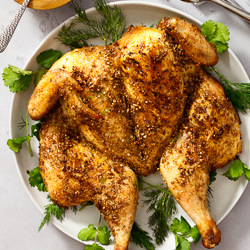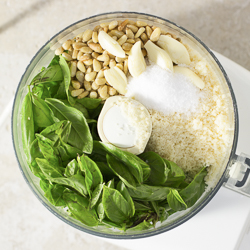From the Pinot Grigio chapter of “100 Perfect Pairings: Main Dishes to Enjoy with Wines You Love” by Jill Silverman Hough (Wiley, 2011)
A pork tenderloin is a great weeknight roast because it cooks so quickly. In this recipe it gets slathered with a simple yet flavorful Dijon mustard sauce and served with a tasty combination of carrots and parsnips.
Serves 6
- 1 pound parsnips, cut into 1/2-inch dice (you should have about 3 cups)
- 12 ounces carrots, cut into 1/2-inch dice (you should have about 2 cups)
- 1/4 cup extra virgin olive oil
- 2 teaspoons coarse kosher salt
- 1/3 cup Dijon mustard
- 2 tablespoons honey
- 1 tablespoon mustard seeds, preferably brown
- Two 1-pound pork tenderloins, trimmed and ideally brined (see below)
Preheat the oven to 450°F. Arrange one rack in the bottom third of the oven and another in the middle.
In a medium bowl, combine the parsnips, carrots, olive oil, and salt, tossing to coat. Spread the mixture on a large, rimmed baking sheet. Set aside.
In a small bowl, combine the mustard and honey. Spread the mixture all over the pork. Place the pork on a rack in a 9 x 13-inch baking pan and pour any remaining mustard mixture over the top. Sprinkle the top of the tenderloins with the mustard seeds. Add about 1/4 inch of water to the bottom of the pan.
Place the pork on the middle rack and roast for 10 minutes.
Place the carrots and parsnips on the bottom rack and continue roasting until an internal thermometer in the pork reads 140°F for medium rare, 15 to 20 minutes. Transfer the pork to a cutting board and let it rest, loosely covered with foil, for 10 minutes. (It will continue to cook, reaching an internal temperature of about 150°F.)
Meanwhile, toss the carrots and parsnips and continue roasting until tender, about 10 minutes.
Slice the pork on an angle and arrange on a platter or plates. Drizzle with any accumulated juices, spoon the carrots and parsnips on top, and serve hot.
FOOD + WINE TIP You could argue that pork is a little heavy for a light wine like Pinot Grigio, yet the pairing works. That’s because the tenderloin, lacking a lot of fat, is one of the lightest cuts of pork. It also works because of the mustard’s brightness.
HOW TO BRINE Brining makes a huge difference with relatively lean cuts of meat that can have a tendency to dry out, helping to keep the meat both juicy and flavorful. If you have the time, I highly recommend it, particularly for pork. It’s also great for turkey, especially for a whole bird, when it’s so easy for the white meat to get dried out waiting for the dark meat to get adequately cooked.
To make a basic brine, combine 2 cups of cool water and 3 tablespoons of coarse kosher salt (use that same proportion to make a larger quantity of brine), stirring to dissolve the salt. Transfer the mixture to a resealable plastic bag, add your meat, and set it aside in the refrigerator. For 1-inch-thick chops or a pork tenderloin, brine for 4 to 6 hours. For a turkey breast, brine for 8 to 12 hours. And for a whole pork loin or whole turkey, brine for 12 to 24 hours (you might need to use a container larger than a resealable bag, then add a plate with something heavy on top to keep the meat submerged).
Remove the meat from the brine (discard the brine), pat it dry, and proceed with your recipe. It’s that easy—and it makes such a difference.









